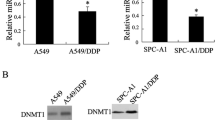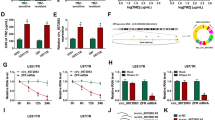Abstract
Methyltransferase-like 14 (METTL14) mediates N6-methyladenosine (m6A) modification to influence cancer progression. This study aims to determine the mechanism of METTL14-mediated m6A in non-small cell lung cancer (NSCLC) cell resistance to cisplatin (DDP). METTL14, miR-19a-5p, RBM24, and AXIN1 expressions in NSCLC tissues/cells were determined. DDP-resistant cell line was obtained, followed by the interference of METTL14 expression. NSCLC cells were treated with DDP to establish a drug-resistant cell line, and METTL14 expression in cells was intervened. The IC50 of NSCLC cells to DDP was measured by CCK-8 assay. NSCLC cell proliferation and apoptosis were observed by clone formation assay and flow cytometry. The content of m6A in total RNA in tissues and cells of NSCLC patients was detected using m6A Methylation Quantification Kit. The expressions of DGCR8-bound pri-miR-19a and m6A-modified pri-miR-19a were detected. The binding relationships between miR-19a-5p and RBM24 and RBM24 and AXIN1 were validated using dual-luciferase assay and RNA immunoprecipitation. Finally, mouse xenograft tumor model was established to verify the role of METTL14 in vivo. METTL14 was highly expressed in NSCLC. METTL14 silencing diminished IC50 to DDP, repressed NSCLC cell proliferation, and enhanced apoptosis. METTL14-mediated m6A induced recognition and processing of pri-miR-19a by DGCR8, thus promoting the transition of pri-miR-19a to miR-19a-5p, repressing RBM24 expression, reducing the binding of RBM24 and AXIN1, and suppressing AXIN1 transcription. miR-19a-5p overexpression or RBM24/AXIN1 silencing abolished the effect of METTL14 silencing on NSCLC cell resistance to DDP. METTL14 silencing in vivo enhanced the suppressive role of DDP to tumor growth. Collectively, METTL14-mediated m6A modification facilitated NSCLC cell resistance to DDP via miR-19a-5p/RBM24/AXIN1 axis.
Key messages
• METTL14 is highly expressed NSCLC and further increased in DDP-resistant cells.
• METTL14 silencing attenuates DDP resistance of NSCLC cells.
• METTL14 promotes the nature of pri-miR-19a by upregulating pri-miR-19a m6A level.
• miR-19a-5p targets RBM24, thus reducing the binding of RBM24 and AXIN1 and inhibiting AXIN1 transcription.
• METTL14 silencing in vivo enhances the suppressive role of DDP to tumor growth.








Similar content being viewed by others
Data availability
The authors confirm that the data supporting the findings of this study are available within the article.
Code availability
Not applicable.
References
Friedlaender A, Addeo A, Russo A, Gregorc V, Cortinovis D, Rolfo CD (2020) Targeted therapies in early stage NSCLC: hype or hope? Int J Mol Sci. https://doi.org/10.3390/ijms21176329
Herbst RS, Morgensztern D, Boshoff C (2018) The biology and management of non-small cell lung cancer. Nature 553:446–454. https://doi.org/10.1038/nature25183
La Montagna M, Ginn L, Garofalo M (2021) Mechanisms of drug resistance mediated by long non-coding RNAs in non-small-cell lung cancer. Cancer Gene Ther 28:175–187. https://doi.org/10.1038/s41417-020-00214-3
Bukowski K, Kciuk M, Kontek R (2020) Mechanisms of multidrug resistance in cancer chemotherapy. Int J Mol Sci. https://doi.org/10.3390/ijms21093233
Fu Y, Dominissini D, Rechavi G, He C (2014) Gene expression regulation mediated through reversible m(6)A RNA methylation. Nat Rev Genet 15:293–306. https://doi.org/10.1038/nrg3724
Sun T, Wu R, Ming L (2019) The role of m6A RNA methylation in cancer. Biomed Pharmacother 112:108613. https://doi.org/10.1016/j.biopha.2019.108613
Li B, Jiang J, Assaraf YG, Xiao H, Chen ZS, Huang C (2020) Surmounting cancer drug resistance: new insights from the perspective of N(6)-methyladenosine RNA modification. Drug Resist Updat 53:100720. https://doi.org/10.1016/j.drup.2020.100720
Yang F, Yuan WQ, Li J, Luo YQ (2021) Knockdown of METTL14 suppresses the malignant progression of non-small cell lung cancer by reducing Twist expression. Oncol Lett 22:847. https://doi.org/10.3892/ol.2021.13108
Kong F, Liu X, Zhou Y, Hou X, He J, Li Q, Miao X, Yang L (2020) Downregulation of METTL14 increases apoptosis and autophagy induced by cisplatin in pancreatic cancer cells. Int J Biochem Cell Biol 122:105731. https://doi.org/10.1016/j.biocel.2020.105731
Sun Z, Wang H, Wang Y, Yuan G, Yu X, Jiang H, Wu Q, Yang B, Hu Z, Shi F et al (2021) MiR-103-3p targets the m(6) A methyltransferase METTL14 to inhibit osteoblastic bone formation. Aging Cell 20:e13298. https://doi.org/10.1111/acel.13298
Leonetti A, Assaraf YG, Veltsista PD, El Hassouni B, Tiseo M, Giovannetti E (2019) MicroRNAs as a drug resistance mechanism to targeted therapies in EGFR-mutated NSCLC: current implications and future directions. Drug Resist Updat 42:1–11. https://doi.org/10.1016/j.drup.2018.11.002
Zhang BY, Han L, Tang YF, Zhang GX, Fan XL, Zhang JJ, Xue Q, Xu ZY (2020) METTL14 regulates M6A methylation-modified primary miR-19a to promote cardiovascular endothelial cell proliferation and invasion. Eur Rev Med Pharmacol Sci 24:7015–7023. https://doi.org/10.26355/eurrev_202006_21694
Hu W, Jin P, Ding C, Liu W (2016) miR-19a/b modulates lung cancer cells metastasis through suppression of MXD1 expression. Oncol Lett 12:1901–1905. https://doi.org/10.3892/ol.2016.4881
Yang CB, Xiao SW, Cheng SM, Zhang C (2020) LncRNA FAS-AS1 inhibits the progression of non-small cell lung cancer through regulating miR-19a-5p. Eur Rev Med Pharmacol Sci 24:3775–3785. https://doi.org/10.26355/eurrev_202004_20842
(2011). In: th (ed) Guide for the care and use of laboratory animals, Washington (DC)
Miranda KC, Huynh T, Tay Y, Ang YS, Tam WL, Thomson AM, Lim B, Rigoutsos I (2006) A pattern-based method for the identification of MicroRNA binding sites and their corresponding heteroduplexes. Cell 126:1203–1217. https://doi.org/10.1016/j.cell.2006.07.031
Muppirala UK, Honavar VG, Dobbs D (2011) Predicting RNA-protein interactions using only sequence information. BMC Bioinformatics 12:489. https://doi.org/10.1186/1471-2105-12-489
Zhang H, Hu B, Wang Z, Zhang F, Wei H, Li L (2017) miR-181c contributes to cisplatin resistance in non-small cell lung cancer cells by targeting Wnt inhibition factor 1. Cancer Chemother Pharmacol 80:973–984. https://doi.org/10.1007/s00280-017-3435-1
Livak KJ, Schmittgen TD (2001) Analysis of relative gene expression data using real-time quantitative PCR and the 2(-Delta Delta C(T)) Method. Methods 25:402–408. https://doi.org/10.1006/meth.2001.1262
Zhang D, Ma Y, Ma Z, Liu S, Sun L, Li J, Zhao F, Li Y, Zhang J, Li S et al (2020) Circular RNA SMARCA5 suppressed non-small cell lung cancer progression by regulating miR-670-5p/RBM24 axis. Acta Biochim Biophys Sin (Shanghai) 52:1071–1080. https://doi.org/10.1093/abbs/gmaa099
Yin YW, Liu KL, Lu BS, Li W, Niu YL, Zhao CM, Yang Z, Guo PY, Qi JC (2021) RBM24 exacerbates bladder cancer progression by forming a Runx1t1/TCF4/miR-625-5p feedback loop. Exp Mol Med 53:933–946. https://doi.org/10.1038/s12276-021-00623-w
Shen DJ, Jiang YH, Li JQ, Xu LW, Tao KY (2020) The RNA-binding protein RBM47 inhibits non-small cell lung carcinoma metastasis through modulation of AXIN1 mRNA stability and Wnt/beta-catentin signaling. Surg Oncol 34:31–39. https://doi.org/10.1016/j.suronc.2020.02.011
Shi XY, Tao XF, Wang GW, He JF, Wu LF, Sun YZ, Sun XJ (2021) LncDBH-AS1 knockdown enhances proliferation of non-small cell lung cancer cells by activating the Wnt signaling pathway via the miR-155/AXIN1 axis. Eur Rev Med Pharmacol Sci 25:139–144. https://doi.org/10.26355/eurrev_202101_24377
Fu X, Li H, Liu C, Hu B, Li T, Wang Y (2016) Long noncoding RNA AK126698 inhibits proliferation and migration of non-small cell lung cancer cells by targeting Frizzled-8 and suppressing Wnt/beta-catenin signaling pathway. Onco Targets Ther 9:3815–3827. https://doi.org/10.2147/OTT.S100633
Xiang M, Liu W, Tian W, You A, Deng D (2020) RNA N-6-methyladenosine enzymes and resistance of cancer cells to chemotherapy and radiotherapy. Epigenomics 12:801–809. https://doi.org/10.2217/epi-2019-0358
Li F, Zhao J, Wang L, Chi Y, Huang X, Liu W (2022) METTL14-mediated miR-30c-1-3p maturation represses the progression of lung cancer via regulation of MARCKSL1 expression. Mol Biotechnol 64:199–212. https://doi.org/10.1007/s12033-021-00406-8
Ma JZ, Yang F, Zhou CC, Liu F, Yuan JH, Wang F, Wang TT, Xu QG, Zhou WP, Sun SH (2017) METTL14 suppresses the metastatic potential of hepatocellular carcinoma by modulating N(6) -methyladenosine-dependent primary microRNA processing. Hepatology 65:529–543. https://doi.org/10.1002/hep.28885
Barbieri I, Tzelepis K, Pandolfini L, Shi J, Millan-Zambrano G, Robson SC, Aspris D, Migliori V, Bannister AJ, Han N et al (2017) Promoter-bound METTL3 maintains myeloid leukaemia by m(6)A-dependent translation control. Nature 552:126–131. https://doi.org/10.1038/nature24678
Kayabasi C, Okcanoglu TB, Yelken BO, Asik A, Susluer SY, Avci CB, Saydam G, Gunduz C (2017) Comparative effect of imatinib and ponatinib on autophagy and miRNome in chronic myeloid leukemia. Gene 637:173–180. https://doi.org/10.1016/j.gene.2017.09.036
Xia RM, Liu T, Li WG, Xu XQ (2021) RNA-binding protein RBM24 represses colorectal tumourigenesis by stabilising PTEN mRNA. Clin Transl Med 11:e383. https://doi.org/10.1002/ctm2.383
Zhang S, Li H, Li L, Gao Q, Gu L, Hu C, Chen M, Zhang X (2021) Ophiopogonin B inhibits migration and invasion in non-small cell lung cancer cells through enhancing the interaction between Axin and beta-catenin. J Cancer 12:6274–6284. https://doi.org/10.7150/jca.60066
Han Y, Zhang Y, Yang LH, Mi XY, Dai SD, Li QC, Xu HT, Yu JH, Li G, Zhao J et al (2012) X-radiation inhibits histone deacetylase 1 and 2, upregulates Axin expression and induces apoptosis in non-small cell lung cancer. Radiat Oncol 7:183. https://doi.org/10.1186/1748-717X-7-183
Wu G, Cao L, Zhu J, Tan Z, Tang M, Li Z, Hu Y, Yu R, Zhang S, Song L et al (2019) Loss of RBMS3 confers platinum resistance in epithelial ovarian cancer via activation of miR-126-5p/beta-catenin/CBP signaling. Clin Cancer Res 25:1022–1035. https://doi.org/10.1158/1078-0432.CCR-18-2554
Picco G, Petti C, Centonze A, Torchiaro E, Crisafulli G, Novara L, Acquaviva A, Bardelli A, Medico E (2017) Loss of AXIN1 drives acquired resistance to WNT pathway blockade in colorectal cancer cells carrying RSPO3 fusions. EMBO Mol Med 9:293–303. https://doi.org/10.15252/emmm.201606773
Funding
This research was supported by funding from the Science and Technology Foundation of Liaoning Province (2022-BS-122).
Author information
Authors and Affiliations
Contributions
All authors contributed to the study conception and design. Material preparation and data collection and analysis were performed by SLG and SYW. The first draft of the manuscript was written by MRS, and all authors commented on previous versions of the manuscript. All authors read and approved the final manuscript.
Corresponding author
Ethics declarations
Ethics approval
This study was conducted with the approval of the ethics committee of the First Affiliated Hospital of China Medical University and in accordance with the Declaration of Helsinki. All participants signed written informed consent. Animal experimental protocols were approved by the animal ethics committee of the First Affiliated Hospital of China Medical University. The protocol was also conducted in compliance with the Guidelines for the Care and Use of Laboratory Animals provisions of administration and usage of laboratory animals [15].
Consent to participate
All participants signed written informed consent.
Consent for publication
All authors have read and approved the final version of the manuscript for publication.
Conflict of interest
The authors declare no competing interests.
Additional information
Publisher's Note
Springer Nature remains neutral with regard to jurisdictional claims in published maps and institutional affiliations.
Supplementary Information
Below is the link to the electronic supplementary material.
Rights and permissions
Springer Nature or its licensor (e.g. a society or other partner) holds exclusive rights to this article under a publishing agreement with the author(s) or other rightsholder(s); author self-archiving of the accepted manuscript version of this article is solely governed by the terms of such publishing agreement and applicable law.
About this article
Cite this article
Gong, S., Wang, S. & Shao, M. Mechanism of METTL14-mediated m6A modification in non-small cell lung cancer cell resistance to cisplatin. J Mol Med 100, 1771–1785 (2022). https://doi.org/10.1007/s00109-022-02268-2
Received:
Revised:
Accepted:
Published:
Issue Date:
DOI: https://doi.org/10.1007/s00109-022-02268-2




